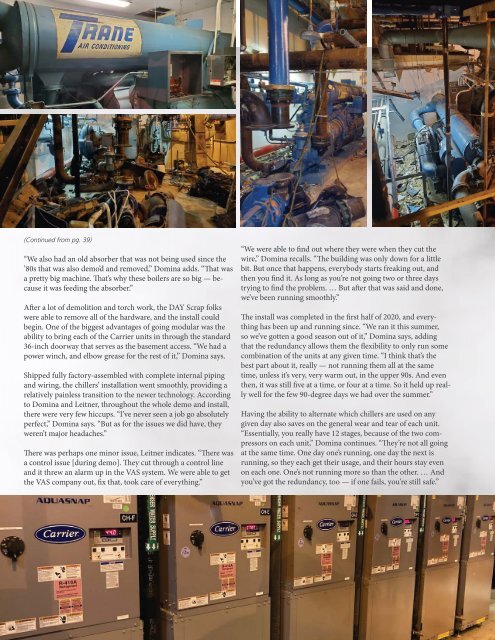CEAC-2021-02-February
Create successful ePaper yourself
Turn your PDF publications into a flip-book with our unique Google optimized e-Paper software.
(Continued from pg. 39)<br />
“We also had an old absorber that was not being used since the<br />
’80s that was also demo’d and removed,” Domina adds. “That was<br />
a pretty big machine. That’s why these boilers are so big — because<br />
it was feeding the absorber.”<br />
After a lot of demolition and torch work, the DAY Scrap folks<br />
were able to remove all of the hardware, and the install could<br />
begin. One of the biggest advantages of going modular was the<br />
ability to bring each of the Carrier units in through the standard<br />
36-inch doorway that serves as the basement access. “We had a<br />
power winch, and elbow grease for the rest of it,” Domina says.<br />
Shipped fully factory-assembled with complete internal piping<br />
and wiring, the chillers’ installation went smoothly, providing a<br />
relatively painless transition to the newer technology. According<br />
to Domina and Leitner, throughout the whole demo and install,<br />
there were very few hiccups. “I’ve never seen a job go absolutely<br />
perfect,” Domina says. “But as for the issues we did have, they<br />
weren’t major headaches.”<br />
There was perhaps one minor issue, Leitner indicates. “There was<br />
a control issue [during demo]. They cut through a control line<br />
and it threw an alarm up in the VAS system. We were able to get<br />
the VAS company out, fix that, took care of everything.”<br />
“We were able to find out where they were when they cut the<br />
wire,” Domina recalls. “The building was only down for a little<br />
bit. But once that happens, everybody starts freaking out, and<br />
then you find it. As long as you’re not going two or three days<br />
trying to find the problem. … But after that was said and done,<br />
we’ve been running smoothly.”<br />
The install was completed in the first half of 2<strong>02</strong>0, and everything<br />
has been up and running since. “We ran it this summer,<br />
so we’ve gotten a good season out of it,” Domina says, adding<br />
that the redundancy allows them the flexibility to only run some<br />
combination of the units at any given time. “I think that’s the<br />
best part about it, really — not running them all at the same<br />
time, unless it’s very, very warm out, in the upper 90s. And even<br />
then, it was still five at a time, or four at a time. So it held up really<br />
well for the few 90-degree days we had over the summer.”<br />
Having the ability to alternate which chillers are used on any<br />
given day also saves on the general wear and tear of each unit.<br />
“Essentially, you really have 12 stages, because of the two compressors<br />
on each unit,” Domina continues. “They’re not all going<br />
at the same time. One day one’s running, one day the next is<br />
running, so they each get their usage, and their hours stay even<br />
on each one. One’s not running more so than the other. … And<br />
you’ve got the redundancy, too — if one fails, you’re still safe.”<br />
40<br />
| Chief Engineer


















